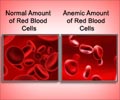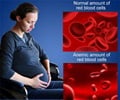Anemia affects more than 25% of the global population. Researchers made the detection of anemia easy with the help of images of patients taken using smartphones.
- New smartphone-based computational models can help diagnose anemia without the need for lab tests
- Anemia affects more than 25% of the global population
- Smartphone algorithms can detect anemia with 72% accuracy
TOP INSIGHT
Paleness of the palpebral conjunctiva (the membrane that coats the inside of the eyelids) can be a sign of severe anemia. Smartphone algorithms can predict anemia with 72.6% accuracy.
Read More..
Why is Anemia an Issue of Concern?
Anemia is a condition that arises due to a reduction in the normal levels of red blood cells or hemoglobin. The common causes of anemia include nutritional deficiencies, especially iron, folate, vitamin A and B12. Anemia comes with multiple complications, including fatigue, pregnancy issues, digestive disorders, and heart problems. Anemia affects an estimated 5.6% of Americans and more than 25% of the global population. It is also estimated that one-third of all women of reproductive age are anemic.Challenges in the Classical Detection of Anemia
The most commonly used laboratory test for diagnosing anemia is the complete blood count (CBC). Yet, there are also some advanced methods that use imaging and spectrophotometric techniques to detect this condition.As anemia is disproportionately prevalent in rural and other underdeveloped settings where there is inadequate access to healthcare, these kinds of laboratory screening that requires technicians, chemical reagents, and dedicated lab equipment may not be possible. Apart from this, it might not be economically feasible for the people from these areas to spend exclusively on these screening tests.
Detection of Anemia Using Smartphones
The paleness of the palpebral conjunctiva that lines the eyelids can be a sign of severe anemia. By taking this in mind, the study team received smartphone images of that conjunctiva from 142 people with a wide range of hemoglobin levels. They zoomed in to a particular small region in each of these photos and designed an algorithm and prediction model which can compare conjunctiva color to hemoglobin levels.When they tested these newly developed algorithms on the conjunctiva photos of 202 new patients, they have reached 72.6% accuracy in predicting anemia. The sensitivity and specificity of the models were 72.8% and 72.5%, respectively.
The authors said, "Images of the lower eyelid's vascular surface obtained by a smartphone camera can be utilized to estimate blood hemoglobin concentration and predict anemia which is a serious health condition afflicting billions of people worldwide with a disproportionate effect in developing countries. Utilization of non-invasive techniques to detect anemia opens the door to widespread screening, early diagnosis, and treatment, particularly in low resource settings where access to healthcare is sparse."
Although the team opines that further improvements in image quality and computational corrections can enhance estimates of haemoglobin, this breakthrough approach can be efficiently used to detect anemia where healthcare facilities are not readily available.
References :
- Suner S, Rayner J, Ozturan IU, Hogan G, Meehan CP, Chambers AB, Baird J, Jay GD. Prediction of anemia and estimation of hemoglobin concentration using a smartphone camera. PLoS One. 2021 Jul 14;16(7):e0253495. doi: 10.1371/journal.pone.0253495. PMID: 34260592.
- Anaemia - (https://www.who.int/health-topics/anaemia#tab=tab_1)
- Anemia - (https://www.mayoclinic.org/diseases-conditions/anemia/symptoms-causes/syc-20351360)
Source-Medindia
 MEDINDIA
MEDINDIA





 Email
Email










